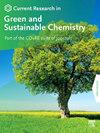采用新的优化工艺,采用绿色法提高红龙果皮中抗氧化剂的提取效率
Q2 Materials Science
Current Research in Green and Sustainable Chemistry
Pub Date : 2025-01-01
DOI:10.1016/j.crgsc.2025.100474
引用次数: 0
摘要
本研究首次采用响应面法(RSM)和人工神经网络遗传算法(ANN-GA)相结合的方法,将超声和酶提取技术作为绿色技术应用于红肉火龙果果皮中生物化合物的回收。火龙果果皮超声预处理10 - 30min (X1),然后用0.1% Pectinex Ultra SP-L酶在30 - 60℃(X2)温度下水解60 - 120 min (X3)。实验采用Box-Behnken设计。利用提取物中多酚、甜菜花青素和抗氧化活性的水平来评估提取方法的效果。研究表明,超声波预处理技术在火龙果皮酶解过程中的应用大大提高了效率。研究确定了ANN-GA法提取工艺的理想参数:超声时间27.5 min,酶培养温度47.1℃,酶培养时间135.1 min。在此条件下,经DPPH自由基清除活性测定,总酚含量为165.34 mg GAE/g果皮重,甜菜菁苷含量为131.87 mg/100 g果皮重,抗氧化活性为0.92 mg TE/100 g。研究表明,双重处理提高了火龙果果皮中化学物质的提取效率。该研究为今后研究有效提取技术的利用和整合奠定了基础,以提高食品行业使用的提取物的质量。本文章由计算机程序翻译,如有差异,请以英文原文为准。
Enhancing antioxidant extraction efficiency from red dragon fruit peel by green approach using novel optimization technique
This study is the first application of a combined sonication and enzyme extraction technique as green technology to recover biological compounds from the peel of red-fleshed dragon fruit, utilizing Response Surface Methodology (RSM) and Artificial Neural Network-Genetic Algorithm (ANN-GA). The peel of dragon fruit had sonication pretreatment for 10–30 min (X1), followed by hydrolysis using 0.1 % Pectinex Ultra SP-L enzyme at temperatures ranging from 30 to 60 °C (X2) for a duration of 60–120 min (X3). The Box-Behnken design was employed to structure the experiment. The levels of polyphenol, betacyanin, and antioxidant activity in the extract were utilized to assess the efficacy of the extraction method. The research demonstrated a substantial enhancement in efficiency by the application of ultrasound pretreatment during the enzymatic hydrolysis of dragon fruit peel. The study identified the ideal parameters for the extraction process using the ANN-GA approach, which include an ultrasonic duration of 27.5 min, an enzyme incubation temperature of 47.1 °C, and an enzyme incubation duration of 135.1 min. Under these conditions, the extract exhibited a total phenolic content of 165.34 mg GAE/g peel weight, betacyanin content of 131.87 mg/100 g peel weight, and an antioxidant activity of 0.92 mg TE/100 g by using DPPH radical scavenging activity assay. The research demonstrated that dual treatment enhances the extraction process of chemicals from by-products, particularly dragon fruit peel. The study established a foundation for future research on the utilization and integration of effective extraction technologies to enhance the quality of extracts for use in the food sector.
求助全文
通过发布文献求助,成功后即可免费获取论文全文。
去求助
来源期刊

Current Research in Green and Sustainable Chemistry
Materials Science-Materials Chemistry
CiteScore
11.20
自引率
0.00%
发文量
116
审稿时长
78 days
 求助内容:
求助内容: 应助结果提醒方式:
应助结果提醒方式:


